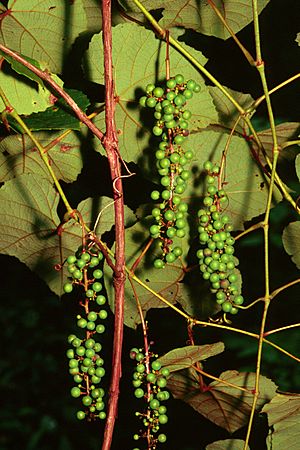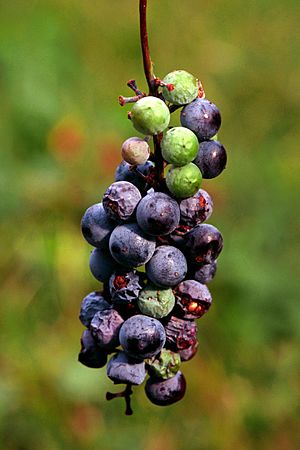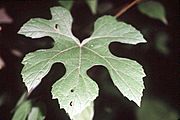Summer grape facts for kids
Quick facts for kids Summer grape |
|
|---|---|
 |
|
| Scientific classification | |
| Genus: |
Vitis
|
| Species: |
aestivalis
|
Vitis aestivalis, also known as the summer grape or pigeon grape, is a type of grape plant. It grows naturally in eastern North America. You can find it from southern Ontario in Canada, east to Maine, west to Oklahoma, and south to Florida and Texas in the United States.
This plant is a strong vine that can grow very tall, sometimes over 10 meters (about 33 feet) high, often climbing on trees. Its leaves are usually roundish and a bit wider than they are long, measuring about 7–20 centimeters (3–8 inches). They can have different shapes, from smooth edges to three or five deep lobes. The top of the leaves is green, and the underside is covered in thick hairs.
The flowers grow in a thick cluster called a panicle, which is about 5–15 centimeters (2–6 inches) long. These clusters appear at every third node (a point on the stem where leaves or branches grow). The fruit is a small grape, about 5–14 millimeters (0.2–0.5 inches) wide. It is dark purple or black when ripe. The summer grape is the official state grape of Missouri. It likes to grow in dry, higher areas.
There are different types, or varieties, of the summer grape:
- V. a. var. aestivalis
- V. a. var. bicolor (also called Silverleaf Grape): This type was once thought to be a separate species, Vitis bicolor. Now, it's known as a northern version of the summer grape. It grows in the Northeastern United States and parts of Southern Ontario.
- V. a. var. lincecumii
- V. a. var. bourquiniana: This type grows in the southern parts of North America. It's sometimes called Vitis bourquiniana. Its leaves have soft, fuzzy hairs on the underside.
Growing and Using Summer Grapes
People have chosen and grown several special types of summer grape. One famous type is 'Norton'. This grape has a lot of V. aestivalis in its background. Many believe it is the oldest American grape type still grown for business today.
Grapes that are a mix of V. aestivalis and other types, like Norton, have good qualities for making wine. Compared to other native North American grapes, they have less sourness, a taste that is not too strong (like European grapes), good structure from tannins, and they are very good at fighting off diseases.
Unlike most other types of Vitis plants, the summer grape does not grow well from simple cuttings (small pieces of the plant). This makes it harder to grow many of them for making wine, even though they have good qualities for wine-making. To grow new summer grape plants, people usually use methods like layering (bending a branch to the ground to root) or using green cuttings (cuttings from new, soft growth). This plant usually does not grow well in soils that have a lot of lime (a type of calcium).
Some people say that a type of V. aestivalis was grown by the Cherokee people. They might have used it in some of their special ceremonies.
Images for kids
- Vitis aestivalis
See also
 In Spanish: Vitis aestivalis para niños
In Spanish: Vitis aestivalis para niños





